![]()

George E. K. Awai (seated) and his Royal Hawaiian Quartette at the Panama-Pacific International Exposition, San Franciso, 1915. Standing (left to right): Ben Zablan (8 string ukulele), Bill Kaina (ukulele), and Henry Komomua (guitar).
In 1915 the ukulele began it's popularity on the U.S. mainland. That was the year of the Panama-Pacific International Exposition in San Francisco, where Hawaii hosted a pavillion. The exposition celebrated the completion of the Panama Canal and lasted for 7 months. With exhibits from countries all over the world it attracted more then 17 million people, an amazing number considering the population in those days. The Territory of Hawaii viewed it as an important opportunity to promote its products, land, people and tourism, and the legislature appropriated over $100,000 for a Hawaiian Pavilion. The main attraction turned out to be the Hawaiian show featuring hulas and songs which ran many times a day. The music created a sensation, with such great musicians as Jonah Kumalae, the ukulele maker, and the Royal Hawaiian Quartette. Legend has it that the song "On the Beach At Waikiki" was the first big hit. This was the first time that Hawaiian music had been promoted on the U.S. mainland and it soon swept the country.

Hawaiian music had been presented at a number of expositions and fairs on the mainland before 1915. The Royal Hawaiian Band went to the Chigago Fair in 1895; Mekia Kealakai and his band had traveled to Buffalo for the World's Fair in 1901; and again the Royal Hawaiian Band went to the Lewis and Clark Exposition in 1905. But it was the Panama-Pacific International Exposition in San Francisco in 1915 which had the greatest impact and started a Hawaiian music craze across the country. By the next year, Tin Pan Alley produced dozens of Hawaiian songs, more than it had ever done before. Also in 1916, Victor Recording Company listed 146 Hawaiian records sold on the mainland, more than any other type of music.

Pulu Moe Trio, left to right: Kaili Sugondo, Louisa Moe, and Pulu Moe.

Johnny Noble and the Moana Hotel Orchestra on the famed Moana Pier, circa 1920s.
Soon, the ukulele was taken up not only by Hawaiian musicians, but by Tin Pan Alley performers too, as it was the perfect little instrument for their style of music. Performers such as Cliff Edwards (aka Ukulele Ike) and Roy Smeck (aka The Wizard of the Strings) were nationally known ukulele musicians, performing live in theaters and on the radio, heard by millions of people. The craze even swept across the Atlantic to England, where George Formby was one of that country's most popular performers.


Cliff "Ukulele Ike" Edwards and Roy Smeck
One effect of the mainland ukulele fad was the increase in demand for ukuleles, which led to a boom in ukulele manufacturing in Hawaii and also the mainland. Of the three original Portuguese ukulele makers, only Manuel Nunes remained. But by 1910, orders were coming in so fast that Nunes couldn't keep up and new competitors entered the field, including James Anahu and Jonah Kumalae, who in 1911 switched from being an ivory carver to a ukulele maker. In 1914, Kumalae opened a new factory that was able to turn out 300 instruments a month. Soon, many more ukulele makers entered the market, including Samuel K. Kamaka, Ernest K. Kaai, Clarence Kinney, and the Aloha Ukulele Company. Despite all of the competition, there seemed to be plenty of business to go around, as orders were streaming in not only from Hawaii, but all over the mainland.
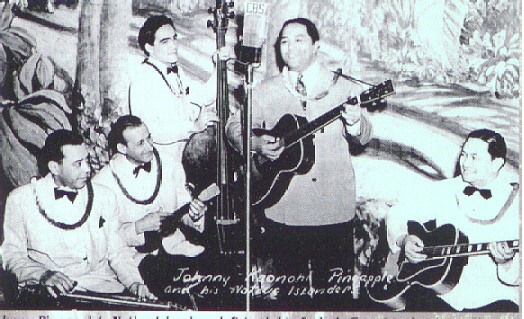
Johnny Pineapple's Native Islanders
Hawaii was soon to get a big jolt, however, as mainland guitar companies entered the ukulele market. The Hawaiian reaction even made national headlines, as evidenced by an article in the New York Times in September, 1915: "Hawaiians are angry... The Hawaiians, according to a report from commercial agent A.P. Taylor, are angry because certain manufacturers of musical instruments in the U.S. are making ukuleles and stamping them with the legend, "Made in Hawaii"....The thing makes a sweet jingle somewhat as fetching as the melody of mandolins and the word "ukulele" describes the Hawaiian appreciation of it, the wold meaning "dancing flea". The Hawaiians are devising a distinctive trademark which they will ask to have protected by legislation. They want authority to place on the instrument made in the Islands the legend: "Made in Hawaii, U.S.A." and making it a misdemeanor to use this legend on the instruments made in the U.S." Indeed, soon most Hawaiian made ukuleles had the word "Tabu" on them. When you find an old ukulele with this word, it was a Hawaiian made instrument from this era.
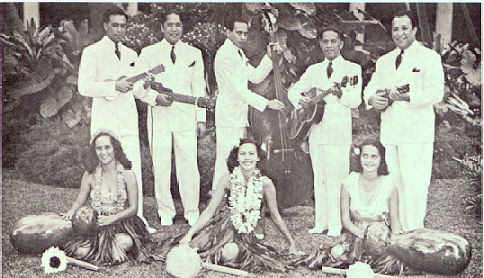
Ray Kinney and his Hotel Lexington Band, circa 1930s.
By the late 30s, the first ukulele boom was over, and America turned it's attention to other styles of music. But then the Second World War came and went and servicemen coming back from Pearl Harbor brought back with them a love of the Islands and it's music and often brought back the little 4-stinged instrument. By the early 50s, the ukulele was seeing it's renaissance, thanks in large part to one of the most popular TV shows of it's time, "Arthur Godfrey and his Ukulele". There was even a special plastic ukulele, called the "TV Pal", that you could buy for a few dollars and strum along to Arthur every Tuesday and Friday night. Millions of these ukuleles were sold, and as strange as it may seem, they weren't all that bad. The instruments were made well and had a pretty good sound.

By the mid 60s, the second uke boom was over. Vietnam, rock and roll, Tiny Tim...there were a miriad of reasons. By the early 70s, Kamaka was the world's only manufacturer of ukuleles.
Today, we are seeing the beginning of a third ukulele boom. In Hawaii, there are many luthiers who have turned their musical instrument making talents to the uke. Kamaka has a 12 month backlog of orders and you'll have even a longer wait if you want a custom made ukulele. The Ukulele Festival, held on the last Sunday in July in Kapiolani Park in Honolulu, is in it's 28th year and features many of the world's great players, including over 400 students from Roy Sakuma's Ukulele School. Mainland ukulele events, such as the Northern California Ukulele Festival and the Uke Expo in Massachusetts draw hundreds of people. Yet another reason is the fact that many ordinary people, most (like yours truly) who have never played a musical instrument before, have found that they can play the relatively easy to learn ukulele. It is light and portable...you can take it just about anywhere (I recently took my Kamaka concert on a 5 week trip all over France, playing to the amusement of many folks who had never heard a ukulele before). In fact, just bring out a ukulele and smiles suddenly appear on everyone's faces. It was Paul McCartney who said, "To this day, if I ever meet grownups who play ukulele, I love 'em." The future of the ukulele looks bright indeed.
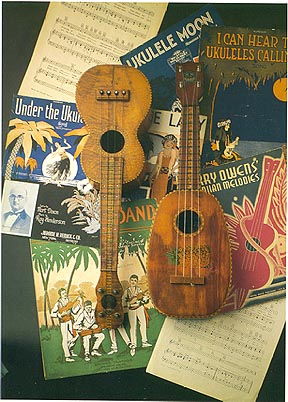
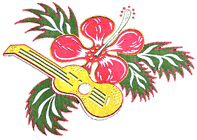
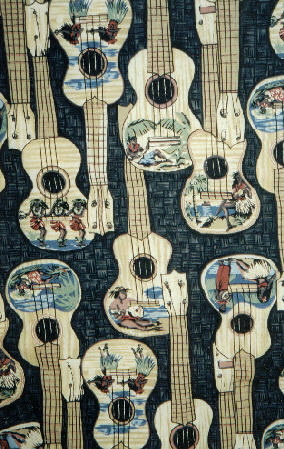
Home | Uke Players
| Beautiful Ukes | Uke History
| Martin Ukes | Kamaka Ukes |
Kamaka Tour | Uke Friends | Brudda IZ | Uke Music
![]()